The importance of our shared leadership will only grow in the coming decades as we work together to address opportunities such as artificial intelligence and space exploration, and challenges such as ensuring clean air, providing access to clean water, and protecting wildlife.
January 2021
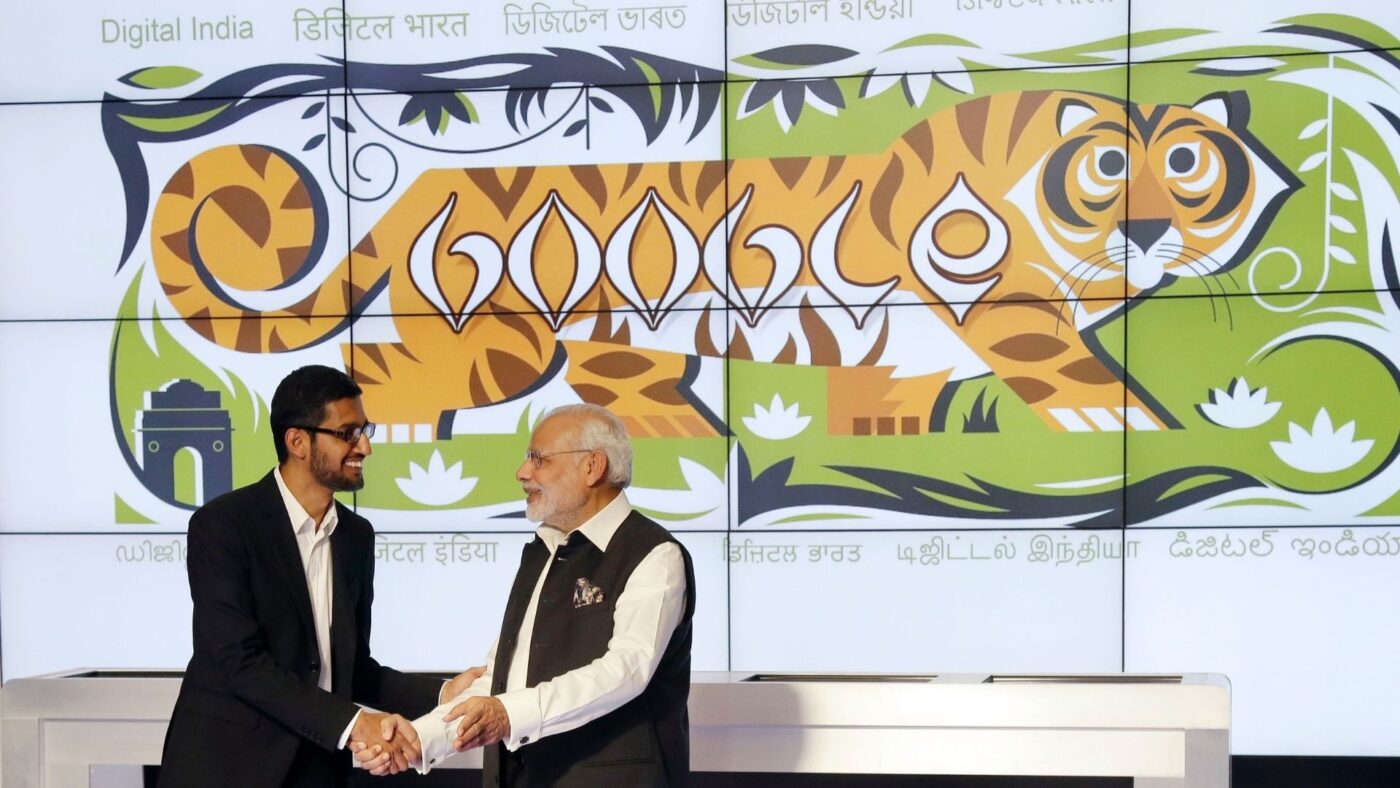
Prime Minister Narendra Modi met with Google CEO Sundar Pichai during a visit to California in 2015. Photograph by Marcio Jose Sanchez © AP Images
The importance of our shared leadership will only grow in the coming decades as we work together to address opportunities such as artificial intelligence and space exploration, and challenges such as ensuring clean air, providing access to clean water, and protecting wildlife.
The United States and India have long shared a commitment to using science to understand the world and to better the lives of our citizens. This dedication has been supported by our two governments; non-profit institutions such as universities, civil society, and foundations; private companies; and countless individuals in both countries. It has been built on a history of exploration and achievement by our peoples, in the case of India stretching back thousands of years. Our cooperation has drawn on a passion to protect our lands, mountains, air, rivers, and wildlife, which hold sacred meaning for many; and our natural resources, when used responsibly, can both power our development and preserve natural habitats.
As our bilateral relationship has grown, so have our joint achievements in science, technology, environment, and space. Our leadership in these fields has helped advance knowledge for the global good. This leadership has been particularly visible in our cooperation on the shared waters of the Indo-Pacific, on global climate issues, and in space. Our collaboration has driven economic growth and improved the health of our people. The importance of our shared leadership will only grow in the coming decades as we work together to address opportunities such as artificial intelligence and space exploration, and challenges such as ensuring clean air, providing access to clean water, and protecting wildlife.
A History of Science and Environmental Cooperation
U.S.-India cooperation on science, technology, and the environment can be traced back to our earliest interactions in the 18th century, when merchants traveled across our shared seas to trade the fruits of our respective natural resources, agricultural practices, and knowledge of textile production. Some of the earliest Indian immigrants to the United States were sailors and dock workers who settled in Massachusetts to apply their skills laboring in the state’s harbors. In 1851, a group of Indians marched in the 4th of July parade in Salem, Massachusetts, carrying a banner for the East India Marine Society. These and other Indians represented the deep appreciation of science and discovery in Indian civilization, expounded by the pundit Jabali in the Ramayana, the 5th century CE mathematician Aryabhata, and the 6th century CE astronomer Varahamihira.
In the late 19th and early 20th centuries, Indians began arriving at U.S. universities to study science. In 1882, Keshav Malhar Bhat traveled from Pune to attend courses at the Massachusetts Institute of Technology (MIT). A number of Indian students studying science in the United States were encouraged by Mahatma Gandhi and his associates, who helped edit letters to Indian industrialists seeking financial support for their studies. Gobind Behari Lal, who later became a Pulitzer Prize-winning science editor of The San Francisco Examiner, studied at the University of California, Berkeley, in 1912. Yellapragada Subbarow became a noted biochemist at Harvard Medical School after his arrival in 1923.
Meanwhile, private American groups, such as the American Marathi Mission, were teaching natural sciences at schools in western India. The Rockefeller Foundation began work in India in 1916, sponsoring a chair in protozoology at the School of Tropical Medicine in Kolkata, and supported projects in science, medicine, and agriculture over the following decades.
Science cooperation expanded after India’s independence in 1947. Space was an important field of early cooperation. In 1963, an eight-person team of Indian space engineers – including future Indian President A.P.J. Abdul Kalam – received training at NASA facilities in Virginia and Maryland, including at the Wallops Flight Facility. That same year, India launched its first rocket, a NASA-provided Nike-Apache rocket, setting the course for India’s own space achievements.
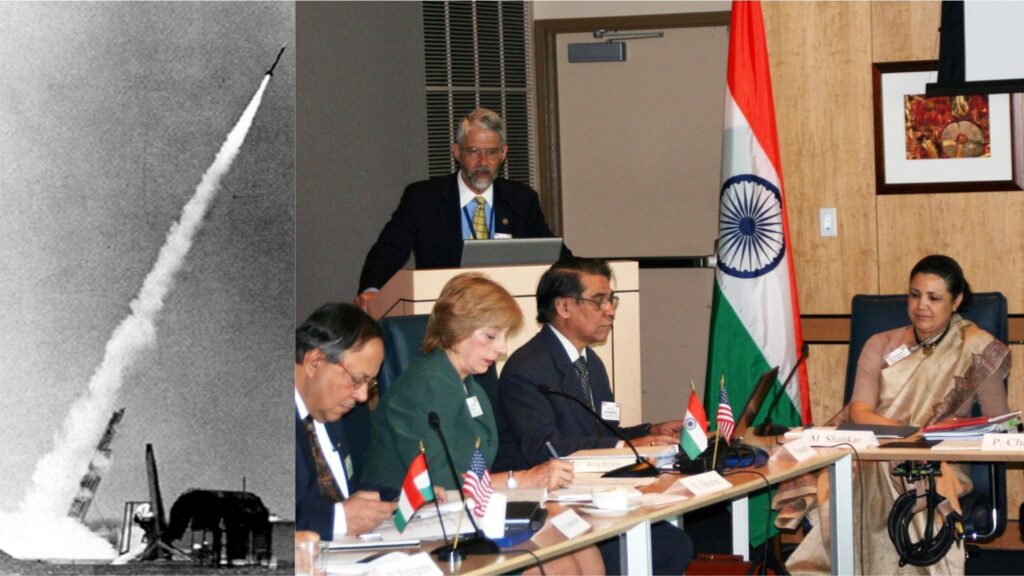
Left: India’s first rocket, a NASA-provided Nike-Apache rocket, launched in 1963. Photograph courtesy Wikipedia
Right: The U.S.-India Joint Commission Meeting on Science and Technology Cooperation in June 2010. Photograph courtesy obamawhitehouse.archives.gov
Non-governmental cooperation in science also grew in the second half of the 20th century. Many American foundations, companies, and universities began operations in India or established relationships with Indian counterparts to cooperate in science, technology, and engineering. Indians who returned from study or work in the United States often made significant contributions. These included S.L. Kirloskar, who studied engineering at MIT and set up the Kirloskar Electric Company Ltd. in Bengaluru and the Kirloskar Oil Engines Ltd. in Pune.
Many Indian immigrants to the United States became leaders in science, engineering, or related fields. For example, Rakesh Gangwal drew on his engineering background to become the CEO of US Airways in 1998, before returning to India to co-found the airline IndiGo. Haryana-born Kalpana Chawla became a NASA astronaut and first traveled to space in 1997. Sunita Williams, whose father’s family comes from Gujarat, also joined the ranks of NASA astronauts. In the 1990s and 2000s, many Indian software engineers contributed to the growth of the information technology industry in the United States.
U.S.-India government cooperation also deepened, including through a $110 million fund to promote science and technology collaboration, formed in 1987. This became the Indo-U.S. Science and Technology Forum in 2000. In 2005, U.S. Secretary of State Condoleezza Rice and Indian Minister of State for Science and Technology Kapil Sibal signed an umbrella Science and Technology Cooperation Agreement to increase collaboration in basic science, space, and other fields.
In 2005, the U.S.-India Joint Working Group on Civil Space Cooperation was founded. In 2008, the Indian Space Research Organisation’s (ISRO) Chandrayaan-1 mission carried two NASA payloads, which helped identify water molecules on the moon. In 2010, the United States and India held the first meetings of the U.S.-India Agriculture Dialogue and the Joint Commission Meeting on Science and Technology Cooperation. This was co-chaired by the Director of the White House Office of Science and Technology Policy, John Holdren, and Indian Minister of State for Science and Technology, and Earth Sciences Prithviraj Chavan.
2015-2020: High-Level Support Increased Science and Technology Cooperation
Cooperation in science, technology, and the environment has strengthened further in the last few years, including with support from our leaders. President Barack Obama discussed joint efforts to advance cooperation in science and technology, including on climate change and scientific exchanges, with Prime Minister Narendra Modi during his January 2015 visit to India. In September 2015, Prime Minister Modi visited Silicon Valley in California, including the premises of Google, Tesla, and Facebook. In the United States, the Prime Minister discussed his Digital India initiative and a wide range of potential private sector technology collaboration opportunities with India. During Prime Minister Modi’s June 2016 visit to the United States, he and President Obama welcomed the formation of a U.S.-India Joint Oversight Group to support the building of a Laser Interferometer Gravitational-Wave Observatory in India. In addition, President Obama and Prime Minister Modi welcomed India’s participation in the Our Ocean Conference in Washington, D.C.
In June 2017, President Donald J. Trump and Prime Minister Modi discussed how the two countries, as global partners, could “further strengthen their collaboration in health, space, oceans, and other areas of science and technology.” In September 2019, President Trump and Prime Minister Modi participated in a public event in Houston, Texas, where the Prime Minister also met with U.S. companies focused on energy, chemicals, and engineering. During President Trump’s February 2020 visit to India, he and Prime Minister Modi again discussed science and technology, and welcomed bilateral progress on Earth observation, Mars exploration, and heliophysics.
Structured bilateral dialogues on science, the environment, technology, and related topics have provided direction and resources to our expanding cooperation. In 2016 alone, the United States and India held a session of the Joint Working Group on Combating Climate Change, a Plant Health Bilateral Meeting, a session of the Joint Committee Meeting on Science and Technology Cooperation, and an Animal Health Bilateral Meeting. We also created new mechanisms, such as the U.S.-India Agricultural Outlook Forum (which was established in 2017 to discuss agricultural policy and the use of technology in farming) and the U.S.-India Ocean Dialogue. The Ocean Dialogue was inaugurated in 2017 at the Council of Scientific and Industrial Research – National Institute of Oceanography (CSIR-NIO) in Goa, to discuss sustainable use of ocean resources for economic growth, while preserving the health of the world’s oceans.
Exploring Space Together, for the Benefit of Humanity
In recent years, space has been one of the most successful areas of our cooperation, ranging from developing advanced satellites for deep-space exploration to increasing private sector space collaboration. Our governments have held productive dialogues on space issues, including meetings of the U.S.-India Civil Space Joint Working Group in 2015 and 2019. We expanded our cooperation to cover emerging security issues in space by launching a new U.S.-India Space Security Dialogue in 2015, and held further rounds in 2016 and 2019.
A prominent example of U.S.-India space cooperation, and the promise it holds for the world, is the joint NASA-ISRO Synthetic Aperture Radar (NISAR). This $1.5 billion, cutting-edge earth observation satellite will improve the ability of scientists to measure and understand some of the planet’s most complex processes. ISRO is providing the S-band radar and NASA’s Jet Propulsion Laboratory (JPL) is providing the L-band radar. The payload will be assembled in the United States before it is shipped to India for an expected launch by ISRO in 2022. JPL has also provided communications support through its Deep Space Network for both of ISRO’s Chandrayaan moon missions and for India’s Mars Orbiter Mission, otherwise known as Mangalyaan. In addition, the U.S. National Oceanic and Atmospheric Administration and U.S. Geological Survey have collaborated with ISRO on data sharing related to global weather and land resources, respectively.
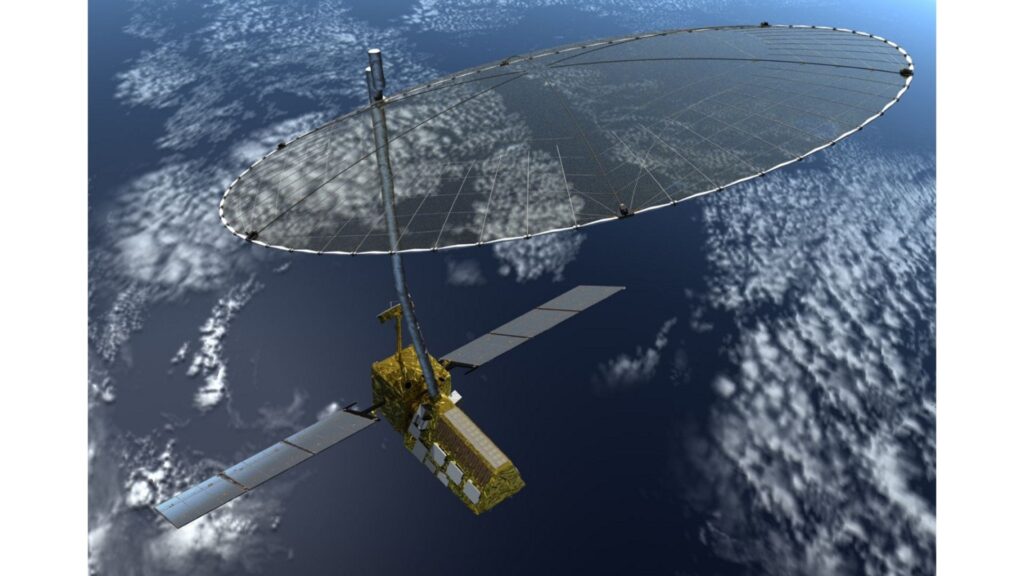
The NASA-ISRO Synthetic Aperture Radar (artist’s concept) is expected to be launched in 2022. Courtesy NASA
The U.S. commercial space industry is increasingly cooperating with India, setting a model for harnessing private sector initiatives. Since 2015, for example, most of the foreign satellites launched by India have been from U.S. companies. In 2017, when ISRO set a world record by launching 104 satellites on one rocket, 96 were from private companies in the United States. Such U.S.-India collaboration has provided a host of global benefits, ranging from improvements in communications to scientific research.
Building Scientific Knowledge through Professional and Academic Exchanges
In recent years, an increasing number of U.S. and Indian scientists have collaborated, thanks in part to exchanges supported by the U.S. and Indian governments, non-profit institutions, and private firms. In September 2014, President Obama and Prime Minister Modi announced the Fulbright-Kalam Climate Fellowship to strengthen our long-term capacity in scientific research to address climate change-related issues. Since its inception in 2016, 31 doctoral and post-doctoral researchers have benefited from the Fellowship. For example, in 2018, the Lawrence Berkeley National Laboratory in California hosted Fulbright-Kalam Fellow Dr. Jayaraman Chillayil. He subsequently published a guide to design, construct, and operate energy efficient buildings in India.
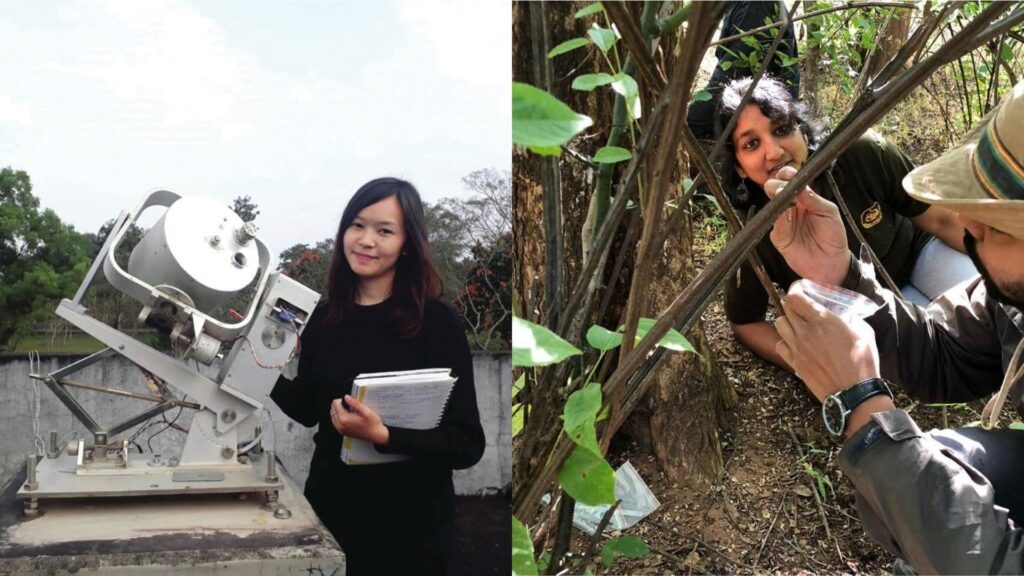
Fulbright-Kalam Climate Fellows and Fulbright-Nehru Fellows from India contribute to academic research on air pollution and wildlife conservation. Left: Photograph courtesy Tamanna Subba. Right: Photograph courtesy Uma Ramakrishnan
The U.S. Mission in India has sponsored the travel of dozens of Indian scientists to the United States on the International Visitor Leadership Program to meet and exchange best practices with U.S. counterparts. Recent programs have focused on biodiversity, clean air, space, and science and technology innovation, among other topics. The U.S.-India Educational Foundation has funded numerous grants under the Fulbright-Nehru Fellowship program for Indians to conduct research in the United States in fields such as bioengineering, climate science, artificial intelligence, and physical sciences. The U.S. Embassy has also sponsored several Science Fellows to visit from the United States for collaboration with Indian counterparts on issues such as supporting women in science and air pollution.
Increasing Collaboration to Combat Air Pollution
In recent years, the United States and India have expanded cooperation to reduce air pollution, a serious challenge for health and economic growth in both countries. The United States, drawing on our own experiences in improving air quality, has contributed to India’s efforts to better understand and monitor air pollution through scientific exchange, technological collaboration, and data collection.
The U.S. Mission in India has installed advanced air quality monitors at its Embassy in New Delhi and its Consulates in Chennai, Hyderabad, Kolkata, and Mumbai, and now shares that information with the Indian scientific community and public. The U.S. Embassy has also provided over 55 low-cost air quality sensors to schools and institutions across North India to increase data collection, while also stimulating interest in air pollution among students. In a February 2020 article in The Mint, Ambassador Kenneth I. Juster highlighted ways India could draw on the experiences of the United States in addressing air pollution.

An air quality sensor being installed in North India. Photograph courtesy
The U.S. Science Envoy for Air Quality, Dr. James Schauer, visited India in 2018 and 2019 to discuss best practices in air pollution enforcement and mitigation with a wide range of Indian researchers, government officials, and civil society organizations. In 2015, Dr. Sri Nadadur of the U.S. National Institute of Environmental Health Sciences spent three months in New Delhi working with partners on a program to research air pollution and its impact on health. The U.S. Centers for Disease Control and Prevention and the National Institutes of Health have worked with the Indian Council of Medical Research and other partners in India on reducing household use of solid fuels for cooking and heating, and on addressing ambient air pollution.
In addition to these government programs, many U.S. and Indian academics are collaborating on air quality research. Emory University in Atlanta, for example, is working with the Sri Ramachandra Institute of Higher Education and Research in Chennai to study the benefits of using liquefied petroleum gas (LPG) for household cooking. This research aligns with Prime Minister Modi’s Ujjwala Yojana program that provides subsidies for LPG to tens of millions of Indian households.
To assist India’s efforts to increase transparency in industrial emissions, the U.S. Agency for International Development (USAID) worked with Indian partners to launch a “star rating” program for industrial plants in 2017. Following its successful roll-out in Maharashtra and Gujarat, other states have announced their intention to adopt the mandatory pollution disclosure scheme. USAID also supported a pilot program in Surat, Gujarat, which allows for market-based regulation of pollution mitigation. This program, supported by the Gujarat Pollution Control Board and designed by the Energy Policy Institute at the University of Chicago, was the first “cap-and-trade” program for particulate emissions in India, and the world.
In addition, U.S. companies have contributed to the battle against air pollution through the provision of technologies that reduce particulate matter emissions and improve energy efficiency. For example, Bharat Heavy Electricals Limited procured twin boiler equipment from GE Power in 2018 for a thermal power project that will increase energy efficiency and reduce pollution.
Protecting Wildlife and Preserving Forests While Promoting Livelihoods
In recent years, the United States and India have expanded a long history of partnering to preserve India’s remarkable national resources and wildlife. The U.S. Fish and Wildlife Service (USFWS) has 19 active programs in India, ranging from building community support for snow leopards to protecting the habitats of India’s sea turtles. The USFWS started a three-year program in 2019 to build support for Asian elephants through protection and education in high-conflict zones surrounding elephant reserves in India’s Western Ghats. Other USFWS grants have supported the protection of Bengal tigers, one-horned rhinos, and hoolock gibbons in Assam and Arunachal Pradesh.
The United States and India are also partnering to counter wildlife trafficking, a major threat to animal species. In 2018, the U.S. Department of State’s Bureau of International Narcotics and Law Enforcement Affairs awarded $1 million grants to the Wildlife Conservation Society of India and the Wildlife Trust of India to train Indian local and national-level officials on best practices in countering wildlife trafficking. According to the Wildlife Conservation Society, initial data from these programs indicate a 100 percent increase in successful prosecutions for wildlife trafficking crimes in the areas in which the projects are operating.
From 2014 to 2019, USAID supported the Tiger Matters program to protect the tiger population in central India. The program, carried out with the Wildlife Conservation Trust, trained thousands of forest and wildlife workers and helped establish new areas for tiger conservation, such as the Umred-Karhandla and the Ghodazari wildlife sanctuaries in Maharashtra.
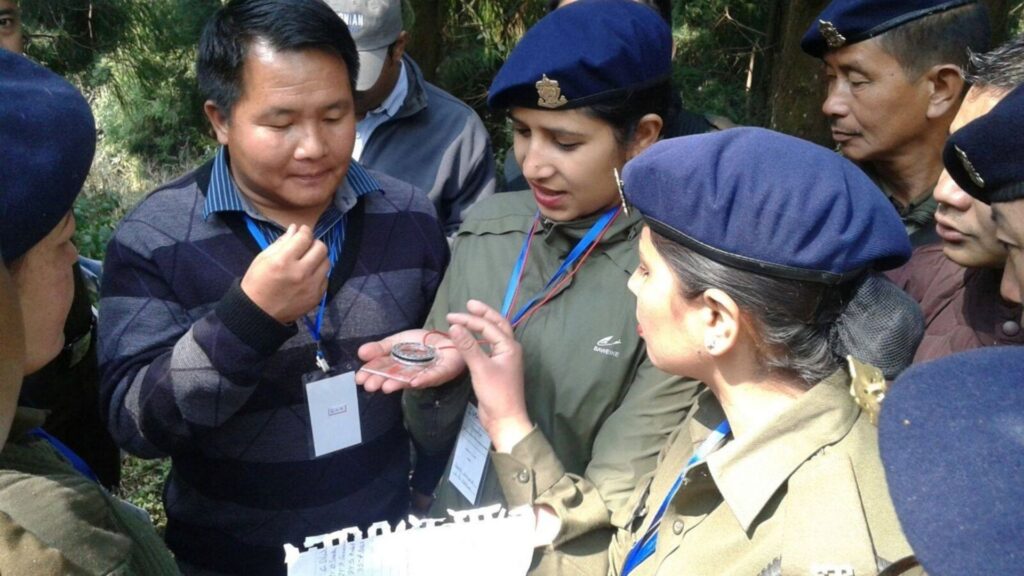
Forest officers participate in USAID’s Forest-PLUS program. Photograph courtesy USAID India
The United States and India have also worked together to preserve the remarkable biodiversity of India’s forests and ecosystems. Partnering with the Ministry of Environment, Forest and Climate Change and the state forest departments of Karnataka, Madhya Pradesh, Sikkim, and Himachal Pradesh, USAID developed new management practices to improve the ecological health and carbon stock of forests in India, as well as the livelihoods of people who depend on the forest. USAID’s Forest-PLUS program worked with the Forest Survey of India on remote-sensed data models and protocols to measure forest conditions in India to provide more accurate estimates of carbon stocks and flows.
Clean Water, Clean World
The United States and Indian governments, along with non-profit and private sector partners, have increased cooperation to improve access to clean water. In December 2019, the U.S. Geological Survey and the Indian Ministry of Jal Shakti signed an agreement on water cooperation. U.S. Consulate General Chennai partnered with the Smithsonian Institution in Washington, D.C. to organize a multi-faceted, two-year campaign called “Water Matters,” which encouraged greater public awareness of and support for sustainable water management. USAID has provided technical assistance to the Atal Mission for Rejuvenation and Urban Transformation, launched by Prime Minister Modi in 2015, to ensure that functional sewage networks are combined with a clean water supply.
The U.S. government has also worked with Indian partners to protect forested catchment areas to sustain rivers and the water they provide. USAID is currently working with the Indian Ministry of Environment, Forest and Climate Change to develop new forest management practices for federal and local officials, including the Van (forest) system. The Van system has already been implemented in Kerala, Telangana, and Bihar to collect data from 300,000 hectares of forested areas, helping the Kerala Forest Department to update its forest management practices.
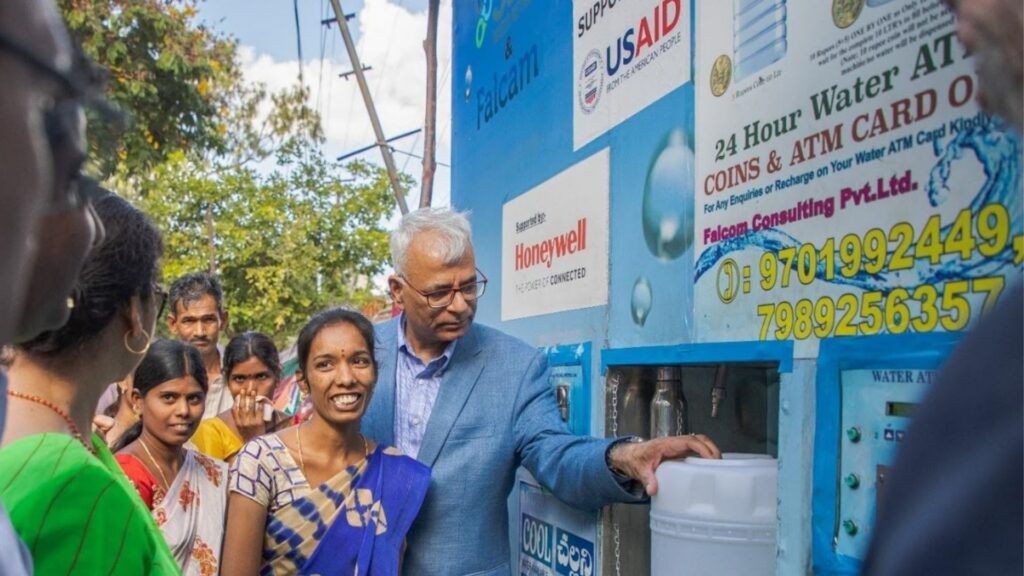
A Safe Water Network kiosk provides clean drinking water in Hyderabad. Photograph by Prabhakar Jayavarapu for USAID
U.S. companies have contributed to these efforts with advanced technologies, including ways to use water more efficiently for residential, agricultural, and industrial purposes. Maine-based IDEXX Laboratories, for example, is a worldwide leader in providing tests for the quality and safety of water, and has worked with many Indian partners and clients. It recently expanded operations in India by establishing an office in Bengaluru to provide water-testing services across several Indian states.
Cooperation in Science Offers a Cleaner, More Productive, and More Sustainable Future
Americans and Indians have long collaborated to share our knowledge, to explore our world, and to preserve the wonders of nature. Our joint efforts have benefited our peoples, our natural environments, and the planet. Many academic, scientific, and commercial technologies and achievements stand witness to this record.
But there is much more to be done, both to contribute to our development and to ensure that we are doing so in clean, ethical, and sustainable ways. As leading democracies, we know that this is our responsibility, to our nations and to the world. We are confident that we will be able to draw on the talents and innovative spirits of our peoples to succeed.
Ensuring Equal Opportunity in Science
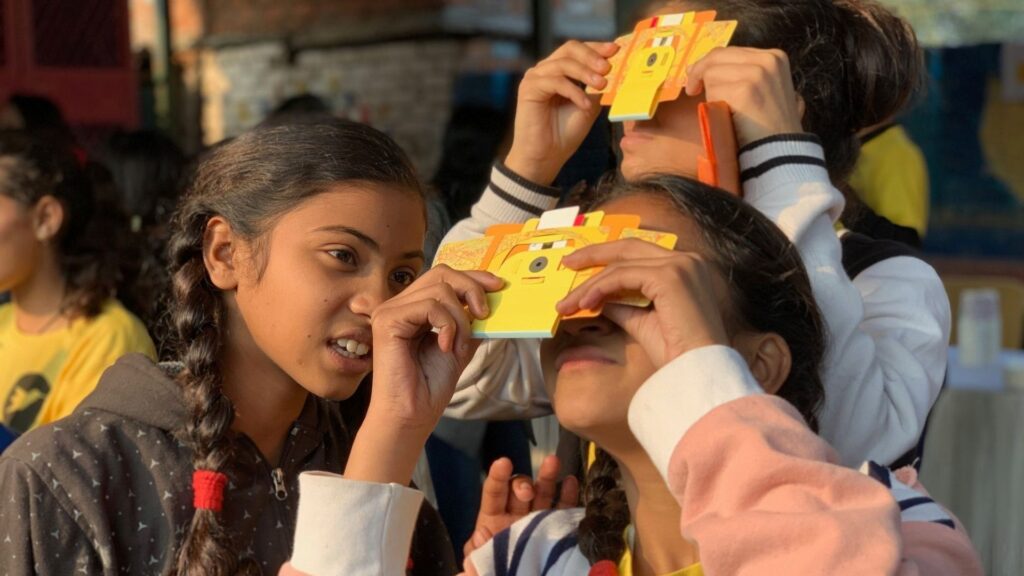
The U.S. Embassy and Consulates encourage girls and women to pursue careers in STEM through a range of events. Photograph courtesy U.S. Embassy New Delhi
The commitment of the United States and India to promoting scientific and technical innovations includes ensuring that everyone has an equal opportunity to pursue STEM education and employment. USAID has partnered with the U.S.-India Strategic Partnership Forum to set up a platform to promote women’s leadership in the energy sector in order to foster gender equality. In addition, the U.S. Embassy has organized a range of events to encourage girls to pursue careers in STEM. In early 2020, the Embassy organized an event that provided microscopes to girls in a New Delhi neighborhood and utilized the microscopes to examine water quality by observing the differences between polluted and clean water. In 2019, Principal Deputy Assistant Secretary of State for the Bureau of Oceans and International Environmental and Scientific Affairs Marcia Bernicat met with female leaders from across the Indian government and NGO community to discuss the landscape in India for women in STEM occupations. In 2016, NASA astronaut Sunita Williams held a STEM roundtable to encourage girls to pursue their dreams in the field of science and technology.
Working Together to Understand Monsoons
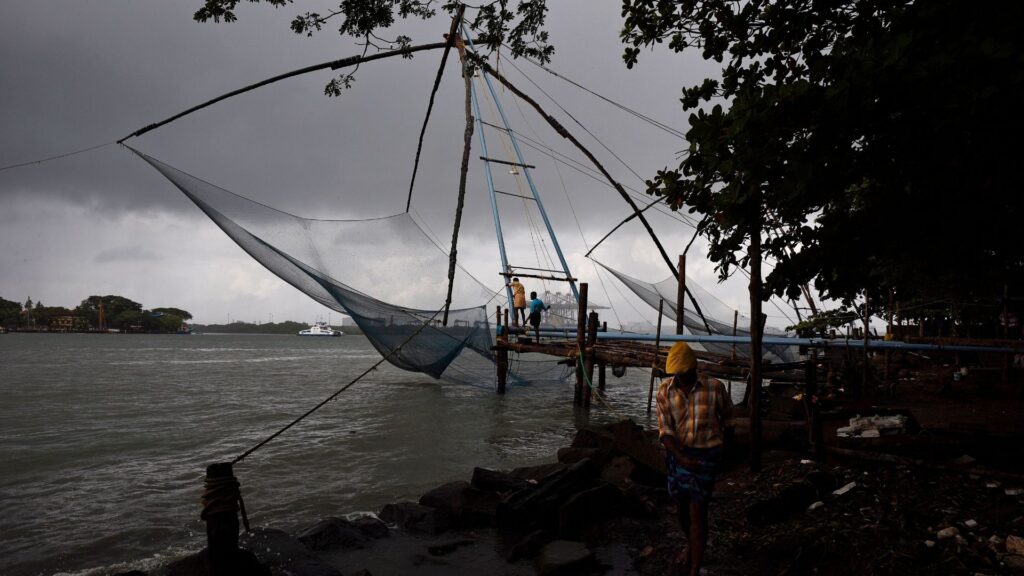
Photograph by R.S. Iyer © AP Images
Beginning in 2012, the U.S. Office of Naval Research funded a five-year program to study the interaction between the sea surface and the atmosphere in monsoon cloud formation. This program operated in collaboration with the Indian Ministry of Earth Sciences. An increased understanding of ocean temperatures and the factors influencing the monsoon will help make weather predictions more accurate and improve predictions of natural disasters, as well as improve agricultural planning and other economic activities.
Supporting the Swachh Bharat Mission
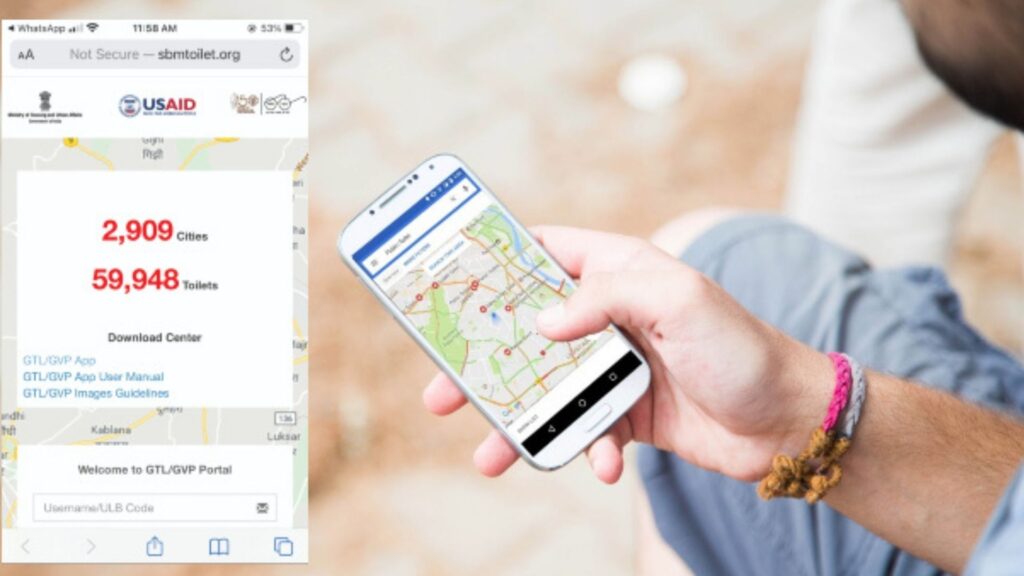
SBM (U) MOHUA
In support of Prime Minister Narendra Modi’s signature “100 million toilets” construction project Swachh Bharat, USAID joined the partnership between Google and the Indian government to develop a toilet locator that helps citizens locate public toilets and provide real-time feedback on their working conditions.
COMMENTS